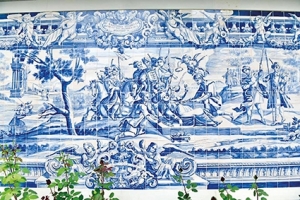Chateau Mukhrani Mural Tells the Story of Queen Ketevan
Georgia is not rich in preserved castles and palaces. However, the ones that can be found on the territory of the country are certainly unique, all carrying an interesting history. One of them is Chateau Mukhrani. Located a thirty-minute drive from the capital city, this is a late 19th century estate, built by Ivane Mukhranbatoni and representing a cultural center of the Georgian elite of the time. Today, Chateau Mukhrani catches the eye of both locals and foreigners with its wonderful castle, vineyards and stunning gardens designed by Versailles gardeners.
While walking through the incredible array of greenery, a huge mural with dominating blue and white colors stands out. While it may seem just décor for the noble garden, the story behind the scene is a tear-jerker.
The replica of the famous Portuguese mural, which was brought to Chateau Mukhrani three years ago, displays the scene of the brutal public torture of Queen Ketevan which took place in Shiraz, Iran (Persia) in 1624 after the Georgian queen refused to renounce the Christian faith and convert to Islam.
Aged 50, Queen Ketevan was robed in festive clothing and led out to a crowded square, where a red-hot copper cauldron was placed on her head, her breasts cut with heated tongs, her body pierced with glowing spears, her fingernails pulled out, a board nailed to her spine and her forehead split with a red-hot spade.
The Portuguese catholic missionary fathers who witnessed the torture of their friend the Georgian queen, were completely devastated.
A few months after her death, the missionary fathers discovered the abandoned grave of the Queen and took the remains of her corpse to Goa (India), Georgia, Italy, France, Portugal and Belgium. Some of the holy relics of Great-Martyr Ketevan were delivered to her son, Teimuraz, King of Kakheti.
One part of the corpse of Queen Ketevan was discovered by Indian archeologists in Goa in 2006.
The tile panel reflecting the tragic story of the Georgian queen was created by Portuguese masters in the 17th century on the order of the Catholic Church. It was damaged in the 20th century and restored only years later, which was followed by the creation of the Georgian replica.
Among the Georgian kings and queens, Ketevan the Martyr is one of the most acclaimed by the Georgian Orthodox Church.
On September 26, the Orthodox Church celebrates the day of Holy Great-Martyr Queen Ketevan.
By Ketevan Kvaratskheliya











